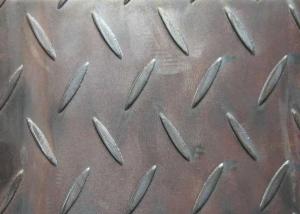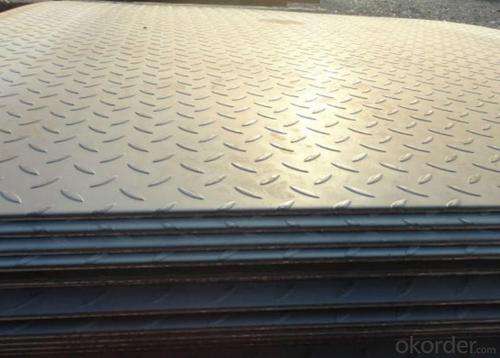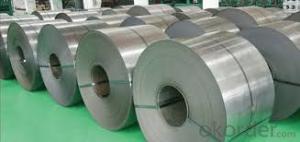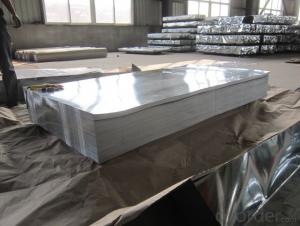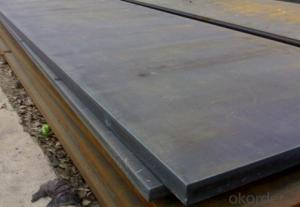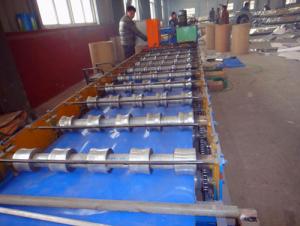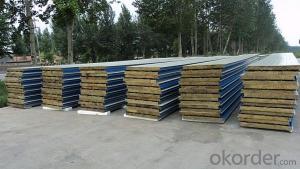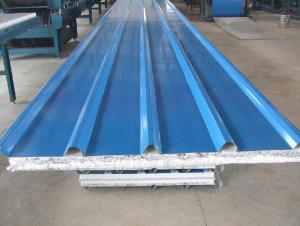Checkered Plate
- Loading Port:
- Xingang Port
- Payment Terms:
- TT or LC
- Min Order Qty:
- 100MT m.t.
- Supply Capability:
- 100000MT/year m.t./month
OKorder Service Pledge
OKorder Financial Service
You Might Also Like
Specification of Checkered Plate:
1. We are specialist in producing and supplying checkered plate to our customers all over the world
Please refer yourself to the informations in below table.
Thickness | 2.5-8.0mm |
Width | 1250mm,1500mm,1800mm,2000mm.,2500mm or as required |
Length | 2000-12000mm |
Standard | AISI, ASTM, BS, DIN, GB, JIS |
Material | A36,SS400, Q195, Q 235,Q345 |
Tehnique | Hot Rolled |
Payment | TT ,L/C |
Packing | Standard seaworthy packing or as required |
Market | Mild east, Africa, Asia North/South America, Europe |
Certificate | SGS China |
Note: we do possess lots of advantages, just as followings:
a) The unfairness of our checkered steel sheet must be less than 10mm each meter
b) The surface of our hot rolled checkered steel sheet is free from bubble, scab, crack, fold, edge delamination and so on.
c) The height of our hot rolled checkered steel sheet will be maintained between 0.2~0.3 times to thickness of steel substrate, but more than 0.5mm at least.
2. The regular sections we provide are shown in the below table:
Base Thickness(MM) | AllowedTolerance ofBaseThickness(%) | Theoretical Mass (KG/M²) | ||
The Pattern | ||||
Rhombus | Beam | Pea | ||
2.5 | ±0.3 | 21.6 | 21.3 | 21.1 |
3.0 | ±0.3 | 25.6 | 24.4 | 24.3 |
3.5 | ±0.3 | 29.5 | 28.4 | 28.3 |
4.0 | ±0.4 | 33.4 | 32.4 | 32.3 |
4.5 | ±0.4 | 37.3 | 36.4 | 36.2 |
5.0 | 0.4~-0.5 | 42.3 | 40.5 | 40.2 |
5.5 | 0.4~-0.5 | 46.2 | 44.3 | 44.1 |
6.0 | 0.5~-0.6 | 50.1 | 48.4 | 48.1 |
7.0 | 0.6~-0.7 | 59.0 | 52.5 | 52.4 |
8.0 | 0.7~-0.8 | 66.8 | 56.4 | 56.2 |
3. Chemical Composition of Checkered Plate:
Our hot rolled checkered plate is usually to roll with ordinary carlbon structure steel. The carbon content value can reach more than 0.06%,0.09% or 0.10%,the maximum value is 0.22%. The silicon content value ranges from 0.12-0.30%, the manganese content value ranges from 0.25-0.65%, and the phosphorus and sulphur content value is commonly less than 0.045%.
Applications of Checkered Plate:
1.Definition: The hot rolled steel sheet with raised pattern on surface. The raised pattern could be shaped as rhombus,bean or pea. There is not only one kind of pattern on the checkered steel sheet, but also a complex of two or more than two kinds of pattern on surface of one checkered steel sheet. It also could be called as grid steel sheet.
2.Character: The Hot Rolled Checkered Steel Sheet possesses a variet of advantages, such as beauty in appearance,skip resistance and saving steel material.Generally speaking,in order to test the mechanical property or the quality of hot rolled checkered steel sheet, the shaping rate and the pattern height should be tested primarily.
3. In conclusion, the hot rolled checkered steel sheet can usually be used in the industry of ship-building,boiler,automobil,tractor,train- building and architecture. In details, there are many demands for hot rolled checkered steel sheet to make floor,ladder at workshop,work frame pedal,ship deck,car floor and so on.
Package & Delivery of Checkered Plate:
1. The items to be prepared for packing include: narrow steel strip, crude steel belt or edge angle steel, kraft paper or galvanized sheet.
2. The hot rolled checkered steel plate should be wrapped with kraft paper or galvanized sheet ouside, and it should be bundled with narrow steel strip, three or two narrow steel strip in longitudinal direction,and the other three or two strips in transverse direction. Furthermore, in order to fix the hot rolled checkered steel sheet and avoid the strip at edge shall be broken, the crude steel belt cut into square should be put under the narrow steel strip on the edge. Of course, the hot rolled checkered steel sheet could be bundled without kraft paper or galvanized sheet. It depends on customer’s requirement.
3. In consideration of the transportaion from mill to loading port, the truck will be usually used. And the maximum quantity for each truck is 40mt.
4. All in all, we could do in accordance with customer's request.
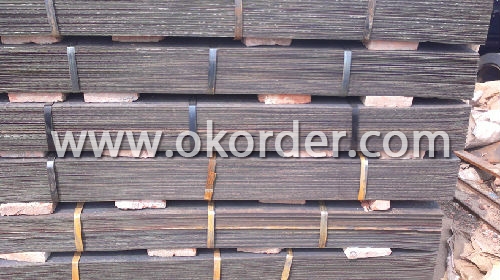
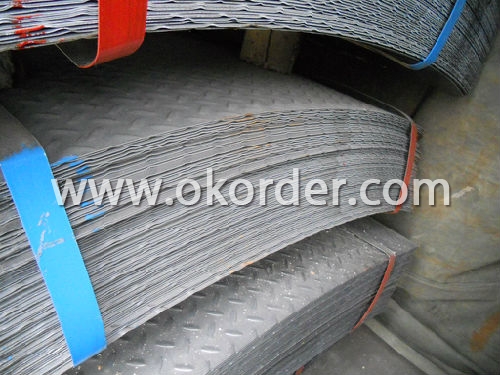
- Q: How are steel sheets protected during cutting and fabrication?
- Steel sheets are protected during cutting and fabrication through various methods such as using protective coatings, applying lubricants, and utilizing automated cutting technologies. These measures help prevent corrosion, reduce friction, and ensure precise and efficient cutting without compromising the quality and integrity of the steel sheets.
- Q: Are steel sheets suitable for railway infrastructure?
- Yes, steel sheets are suitable for railway infrastructure due to their high strength, durability, and resistance to wear and tear. Steel sheets are often used for railway track components such as rails, sleepers, and bridges, as they can withstand heavy loads and provide stability to the railway system. Additionally, steel sheets can be easily fabricated and maintained, making them an ideal choice for railway construction projects.
- Q: Can the steel sheets be bent or formed into different shapes?
- Yes, steel sheets can be bent or formed into different shapes. Steel is a highly malleable material, which means it can be easily manipulated and shaped without breaking. This allows for a wide range of applications where steel sheets need to be bent or formed into specific shapes, such as in the construction industry for manufacturing beams, columns, and other structural components. Various methods, such as cold forming, hot forming, and press braking, can be used to bend or form steel sheets into different shapes, depending on the desired end result and the thickness of the steel.
- Q: Do steel sheets have any magnetic properties?
- Yes, steel sheets can have magnetic properties. The magnetic properties of steel sheets depend on the composition and processing methods used. Some steels, such as carbon steels, are not inherently magnetic, while others, such as stainless steels, can exhibit magnetic behavior.
- Q: Can steel sheets be perforated for ventilation purposes?
- Indeed, ventilation purposes can be achieved through the perforation of steel sheets. Multiple industries and applications frequently employ perforated steel sheets whenever ventilation is necessary. By incorporating perforations into the steel sheets, airflow is enabled while ensuring the material's structural integrity remains intact. The customization of these perforations allows for ventilation requirements to be tailored, encompassing factors like hole size and pattern. Notably, HVAC systems, industrial equipment, architectural endeavors, and acoustic panels, among other applications, greatly benefit from the utilization of perforated steel sheets. This is due to the crucial need for a harmonious equilibrium between ventilation and strength.
- Q: How do steel sheets perform in chemical resistance?
- Steel sheets generally have good chemical resistance due to their high corrosion resistance. The presence of alloying elements such as chromium, nickel, and molybdenum enhances their ability to withstand exposure to various chemicals. However, their performance may vary depending on the specific chemical and concentration involved. It is always advisable to consult the steel manufacturer or refer to corrosion resistance charts for accurate information on a case-by-case basis.
- Q: Can steel sheets be used for water tanks?
- Yes, steel sheets can be used for water tanks. Steel is a durable and strong material that is commonly used for various applications, including water tanks. It provides excellent resistance to corrosion and can withstand high-pressure environments, making it suitable for storing water safely. Additionally, steel tanks can be easily customized to meet specific size and shape requirements.
- Q: What is the average cost of installing steel sheets?
- The average cost of installing steel sheets can vary depending on various factors such as the size of the project, the type and quality of the steel sheets, the location, and the labor costs. On average, the cost of installing steel sheets can range from $7 to $15 per square foot. However, it is important to note that this is just a rough estimate and actual costs may vary significantly. It is recommended to obtain quotes from multiple contractors or steel suppliers to get a more accurate estimate for a specific project.
- Q: Can steel sheets be bent without causing damage?
- Yes, steel sheets can be bent without causing damage, provided that the bending process is done carefully and within the limits of the material's properties. Steel sheets are commonly bent using various techniques such as press brake bending or roll bending. These processes involve applying controlled force and pressure to the sheet to achieve the desired shape without causing any permanent deformation or damage. The ability to bend steel sheets without damage depends on several factors, including the thickness and grade of the steel, the bending radius, and the equipment and technique used. Thinner sheets are generally more flexible and easier to bend, while thicker sheets may require higher forces and specialized equipment. It is essential to consider the steel's tensile strength, yield strength, and elongation properties to ensure that the bending process does not exceed its limits. Excessive bending can lead to cracks, fractures, or permanent deformations, compromising the sheet's structural integrity. To prevent damage during bending, it is crucial to follow proper bending techniques and guidelines. This includes using appropriate tooling, ensuring even distribution of force, and avoiding sharp changes in direction or excessive bending angles. Additionally, preheating the steel sheet can make it more pliable and reduce the risk of damage. In summary, steel sheets can be bent without causing damage, but it requires careful consideration of the material's properties, proper equipment, and adherence to bending guidelines. By employing the right techniques and precautions, steel sheets can be successfully bent into various shapes and forms while maintaining their structural integrity.
- Q: What are the different thickness options for steel sheets?
- The thickness options for steel sheets can vary depending on the specific requirements, but commonly available options range from thin gauges like 30 gauge (0.012 inches) to thicker ones such as 10 gauge (0.134 inches).
1. Manufacturer Overview
| Location | Qianan, China |
| Year Established | 2005 |
| Annual Output Value | Above US$ 1,300 Million |
| Main Markets | Mid East; Eastern Europe; North America |
| Company Certifications |
2. Manufacturer Certificates
| a) Certification Name | |
| Range | |
| Reference | |
| Validity Period |
3. Manufacturer Capability
| a) Trade Capacity | |
| Nearest Port | Tianjin |
| Export Percentage | 40% - 60% |
| No.of Employees in Trade Department | 21-50 People |
| Language Spoken: | English; Chinese |
| b) Factory Information | |
| Factory Size: | Above 800,000 square meters |
| No. of Production Lines | Above 10 |
| Contract Manufacturing | OEM Service Offered; |
| Product Price Range | High; Average |
Send your message to us
Checkered Plate
- Loading Port:
- Xingang Port
- Payment Terms:
- TT or LC
- Min Order Qty:
- 100MT m.t.
- Supply Capability:
- 100000MT/year m.t./month
OKorder Service Pledge
OKorder Financial Service
Similar products
Hot products
Hot Searches
Related keywords


